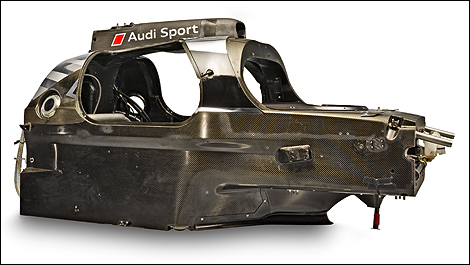May
23rd
Stay connected Subscribe to our RSS feed
In 15 years of development, Audi has set standards with its ultra-lightweight of LMP1 endurance sports prototypes.
Since 1999, ultra-lightweight design has been playing a central role with Audi's Le Mans prototypes (LMP). Materials, such as CFRP (carbon fiber reinforced plastic), harbor major potential for optimizing weight.
Even in its first LMP sports car - the R8R of 1999 - Audi used a carbon fiber monocoque. Audi has significantly been reducing weight to this day.
Although a closed cockpit requires the use of more material Audi has managed to cut the weight of the monocoque in half between 1999 and today, while surpassing all the safety and crash requirements of the FIA.
Furthermore, Audi managed to again increase the torsional strength of the monocoque during this period of time despite the 50 percent reduction in weight.
The chassis design is complemented by the transmission housing. Since 2012, it has been made of a lightweight and stable full-carbon construction in which the mounting points for the rear axle are integrated. In addition, very light backstays from the monocoque to the transmission housing optimize the stiffness of the rear end.
Additionally, numerous smaller solutions have been accompanying the major steps. The carbon fiber gas pedal in the Audi R10 TDI already saved a few hundred grams of weight compared with an aluminum version.
The lithium-ion battery that was used for the first time in the 2009 R15 TDI even proved to be seven kilograms lighter than a lead storage battery.
 |
| Photo: Audi Motorsport |
Since 1999, ultra-lightweight design has been playing a central role with Audi's Le Mans prototypes (LMP). Materials, such as CFRP (carbon fiber reinforced plastic), harbor major potential for optimizing weight.
Even in its first LMP sports car - the R8R of 1999 - Audi used a carbon fiber monocoque. Audi has significantly been reducing weight to this day.
Although a closed cockpit requires the use of more material Audi has managed to cut the weight of the monocoque in half between 1999 and today, while surpassing all the safety and crash requirements of the FIA.
 |
| Carbon monocoque (Photo: Audi Motorsport) |
Furthermore, Audi managed to again increase the torsional strength of the monocoque during this period of time despite the 50 percent reduction in weight.
The chassis design is complemented by the transmission housing. Since 2012, it has been made of a lightweight and stable full-carbon construction in which the mounting points for the rear axle are integrated. In addition, very light backstays from the monocoque to the transmission housing optimize the stiffness of the rear end.
 |
| Audi's V6 TDI engine (Photo: Audi Motorsport) |
Additionally, numerous smaller solutions have been accompanying the major steps. The carbon fiber gas pedal in the Audi R10 TDI already saved a few hundred grams of weight compared with an aluminum version.
The lithium-ion battery that was used for the first time in the 2009 R15 TDI even proved to be seven kilograms lighter than a lead storage battery.
 |
| Carbon transmission casing (Photo: Audi Motorsport) |
 The latest auto news, reviews, prices, product and vehicle releases.
The latest auto news, reviews, prices, product and vehicle releases.